Analysis of Factors of Variation in Characteristics of Boar Ejaculates
Simple Summary
Abstract
1. Introduction
2. Materials and Methods
2.1. Animals and Semen Collection
2.2. Semen Evaluation
2.3. Experimental Design
- Effect of boar:
- Effect of season:
- Effect of boar age:
3. Results
3.1. Structure of Variation Sources
3.2. Effect of Breed
3.3. Effect of Age
3.4. Effect of Season
4. Discussion
5. Conclusions
6. Practical Implications
Author Contributions
Funding
Institutional Review Board Statement
Informed Consent Statement
Data Availability Statement
Conflicts of Interest
References
- Snoj, T.; Kobal, S.; Majdic, G. Effects of season, age, and breed on semen characteristics in different Bos taurus breeds in a 31-year retrospective study. Theriogenology 2013, 79, 847–852. [Google Scholar] [CrossRef] [PubMed]
- Knecht, D.; Jankowska-Mąkosa, A.; Duziński, K. Boar genotype as a factor shaping age-related changes in semen parameters and reproduction longevity simulations. Theriogenology 2017, 98, 50–56. [Google Scholar] [CrossRef]
- Kowalewski, D.; Kondracki, S.; Górski, K.; Bajena, M.; Wysokińska, A. Effect of piggery microclimate on ejaculate performance of artificial insemination boars. Kafkas Univ. Vet. Fak. Derg. 2016, 22, 225–232. [Google Scholar] [CrossRef]
- Górski, K.; Kondracki, S.; Wysokińska, A. Effects of season on semen parameters and relationships between selected semen characteristics in Hypor boars. Turk. J. Vet. Anim. Sci. 2017, 41, 563–569. [Google Scholar] [CrossRef]
- Bajena, M.; Kondracki, S.; Iwanina, M.; Wysokińska, A.; Adamiak, A. Physical characteristics of ejaculates produced by insemination boars depending on the interval between successive ejaculate collections. J. Cent. Eur. Agric. 2016, 17, 260–271. [Google Scholar] [CrossRef]
- Kondracki, S.; Iwanina, M.; Wysokińska, A.; Banaszewska, D.; Kordan, W.; Fraser, L.; Rymuza, K.; Górski, K. The usefulness of sexual behaviour assessment at the beginning of service to predict the suitability of boars for artificial insemination. Animals 2021, 11, 3341. [Google Scholar] [CrossRef]
- Savić, R.; Petrović, M.; Radojković, D.; Radović, Č.; Parunović, N. The effect of breed, boar and season on some properties of sperm. Biotechnol. Anim. Husb. 2013, 29, 299–310. [Google Scholar] [CrossRef]
- Górski, K.; Kondracki, S.; Wysokińska, A. Inter- and intra-breed variation in ejaculate characteristics and in the morphology, dimensions and shape of spermatozoa of boars used for artificial insemination. Folia Pomer. Univ. Technol. Stetin. Agric. Aliment. Pisc. Zootech. 2017, 336, 41–52. [Google Scholar] [CrossRef]
- Oh, S.H.; See, M.T.; Long, T.E.; Galvin, J.M. Estimates of genetic correlations between production and semen traits in boar. Asian Aust. J. Anim. Sci. 2006, 19, 160–164. [Google Scholar] [CrossRef]
- Hong, Y.; Yan, L.; He, X.; Wu, D.; Ye, J.; Cai, G.; Liu, D.; Wu, Z.; Tan, C. Estimates of variance components and heritability using random regression models for semen traits in boars. Front. Genet. 2022, 13, 805651. [Google Scholar] [CrossRef]
- Robinson, J.A.B.; Buhr, M.M. Impact of genetic selection on management of boar replacement. Theriogenology 2005, 63, 668–678. [Google Scholar] [CrossRef] [PubMed]
- Safranski, T.J. Genetic selection of boars. Theriogenology 2008, 70, 1310–1316. [Google Scholar] [CrossRef]
- Banaszewska, D.; Kondracki, S. An assessment of the breeding maturity of insemination boars based on ejaculate quality changes. Folia Biol. 2012, 60, 151–162. [Google Scholar] [CrossRef] [PubMed]
- Kuhlgatz, D.A.; Kuhlgatz, C.; Aepli, M.; Schumann, B.; Grossfeld, R.; Bortfeldt, R.; Jakop, U.; Jung, M.; Schulze, M. Development of predictive models for boar semen quality. Theriogenology 2019, 134, 129–140. [Google Scholar] [CrossRef] [PubMed]
- King, G.J.; Macpherson, J.W. A comparison of two methods for boar semen collection. J. Anim. Sci. 1973, 36, 563–565. [Google Scholar] [CrossRef]
- Schulze, M.; Buder, S.; Rüdiger, K.; Beyerbach, M.; Waberski, D. Influences on semen traits used for selection of young AI boars. Anim. Reprod. Sci. 2014, 148, 164–170. [Google Scholar] [CrossRef]
- Petrunkina, A.M.; Waberski, D.; Günzel-Apel, A.R.; Töpfer-Petersen, E. Determinants of sperm quality and fertility in domestic species. Reproduction 2007, 134, 3–17. [Google Scholar] [CrossRef]
- Sonderman, J.P.; Luebbe, J.J. Semen production and fertility issues related to differences in genetic lines of boars. Theriogenology 2008, 70, 1380–1383. [Google Scholar] [CrossRef]
- Smital, J. Effects influencing boar semen. Anim. Reprod. Sci. 2009, 110, 335–346. [Google Scholar] [CrossRef]
- Kondracki, S.; Wysokińska, A.; Iwanina, M.; Banaszewska, D.; Sitarz, D. Effect of sperm concentration in an ejaculate on morphometric traits of spermatozoa of Duroc boars. Polish J. Vet. Sci. 2011, 14, 35–40. [Google Scholar] [CrossRef]
- Kondracki, S.; Iwanina, M.; Wysokińska, A.; Huszno, M. Comparative analysis of Duroc and Pietrain boar sperm morphology. Acta Vet. Brno 2012, 81, 195–199. [Google Scholar] [CrossRef]
- Savić, R.; Petrović, M.; Radojković, D.; Radović, Č.; Parunović, N. Libido and ejaculate traits of performance tested boars. J. Anim. Plant Sci. 2014, 24, 1649–1654. [Google Scholar]
- Valverde-Abarca, A.; Madrigal-Valverde, M.; Solis-Arias, J.; Paniagua-Madrigal, W. Variabilidad en los métodos de estimación de la concentración espermática en verracos. Agron. Costarric. 2019, 43, 25–43. [Google Scholar] [CrossRef]
- Kondracki, S.; Górski, K.; Iwanina, M. Impact of sperm concentration on sperm morphology of large white and landrace boars. Livest. Sci. 2020, 241, 104214. [Google Scholar] [CrossRef]
- Knecht, D.; Środoń, S.; Duziński, K. The influence of boar breed and season on semen parameters. S. Afr. J. Anim. Sci. 2014, 44, 1–9. [Google Scholar] [CrossRef]
- Kondracki, S.; Banaszewska, D.; Bajena, M.; Komorowska, K.; Kowalewski, D. Correlation of frequency of spermatozoa morphological alterations with sperm concentration in ejaculates of polish landrace boars. Acta Vet. Beogr. 2013, 63, 513–524. [Google Scholar] [CrossRef]
- Zapryanova, I. Dependencies between some traits of sperm production of boars at different age. Biotechnol. Anim. Husb. 2017, 33, 151–159. [Google Scholar] [CrossRef]
- Górski, K.; Kondracki, S.; Wysokińska, A.; Iwanina, M. Dependence of sperm morphology and ejaculate characteristics on sperm concentration in the ejaculates of Hypor boars. J. Vet. Res. 2018, 62, 353–357. [Google Scholar] [CrossRef]
- Wysokińska, A.; Kondracki, S. Assessment of the effect of heterosis on semen parameters of two-breed crosses of Duroc, Hampshire and Pietrain boars. Arch. Tierz. 2013, 56, 65–74. [Google Scholar] [CrossRef]
- Wolf, J.; Smital, J. Quantification of factors affecting semen traits in artificial insemination boars from animal model analyses. J. Anim. Sci. 2009, 87, 1620–1627. [Google Scholar] [CrossRef]
- Tereszkiewicz, K.; Pokrywka, K. Evaluation and prediction of semen parameters of breeding boars and their use in stock management. Int. J. Adv. Appl. Sci. 2019, 6, 48–53. [Google Scholar] [CrossRef]
- Górski, K.; Kondracki, S.; Iwanina, M.; Kordan, W.; Fraser, L. Effects of breed and ejaculate volume on sperm morphology and semen parameters of boars. Anim. Sci. J. 2021, 92, e13629. [Google Scholar] [CrossRef]
- Kanokwan, K. Association and Expression Study of CD9, PLCz, and COX-2 as Candidate Genes to Improve Boar Sperm Quality and Fertility Traits. Ph.D. Thesis, Institut für Tierwissensechaften, Abt, Tierzucht und Tierhaltung der Rheinischen Friedrich-Wilhelms-Universität Bonn, Bonn, Germany, 2009. [Google Scholar]
- Kumaresan, A.; Bujarbaruah, K.M.; Karunakaran, M.; Das, A.; Bardoloi, R.K. Assessment of early sexual maturity in nondescript local pigs of northeast India: Testicular development, spermiogram and in vivo pregnancy. Livest. Sci. 2008, 116, 342–347. [Google Scholar] [CrossRef]
- Clark, S.G.; Schaeffer, D.J.; Althouse, G.C. B-Mode ultrasonographic evaluation of paired testicular diameter of mature boars in relation to average total sperm numbers. Theriogenology 2003, 60, 1011–1023. [Google Scholar] [CrossRef] [PubMed]
- Flowers, W.L. Genetic and phenotypic variation in reproductive traits of AI boars. Theriogenology 2008, 70, 1297–1303. [Google Scholar] [CrossRef]
- Knecht, D.; Jankowska-Mąkosa, A.; Duziński, K. The effect of age, interval collection and season on selected semen parameters and prediction of AI boars productivity. Livest. Sci. 2017, 201, 13–21. [Google Scholar] [CrossRef]
- Fraser, L.; Strzeżek, J.; Filipowicz, K.; Mogielnicka-Brzozowska, M.; Zasiadczyk, L. Age and seasonal-dependent variations in the biochemical composition of boar semen. Theriogenology 2016, 86, 806–816. [Google Scholar] [CrossRef]
- Hallap, T.; Jaakma, U.; Rodriguez-Martinez, H. Changes in semen quality in Estonian Holstein AI bulls at 3, 5 and 7 years of age. Reprod. Domest. Anim. 2006, 41, 214–218. [Google Scholar] [CrossRef]
- Rijsselaere, T.; Maes, D.; Hoflack, G.; De Kruif, A.; Van Soom, A. Effect of body weight, age and breeding history on canine sperm quality parameters measured by the Hamilton-Thorne analyser. Reprod. Domest. Anim. 2007, 42, 143–148. [Google Scholar] [CrossRef]
- Goericke-Pesch, S.; Failing, K. Retrospective analysis of canine semen evaluations with special emphasis on the use of the hypoosmotic swelling (HOS) test and acrosomal evaluation using Spermac®. Reprod. Domest. Anim. 2013, 48, 213–217. [Google Scholar] [CrossRef]
- Johnson, S.L.; Dunleavy, J.; Gemmell, N.J.; Nakagawa, S. Consistent age-dependent declines in human semen quality: A systematic review and meta-analysis. Ageing Res. Rev. 2015, 19, 22–33. [Google Scholar] [CrossRef] [PubMed]
- Halvaei, I.; Litzky, J.; Esfandiari, N. Advanced paternal age: Effects on sperm parameters, assisted reproduction outcomes and offspring health. Reprod. Biol. Endocrinol. 2020, 18, 110. [Google Scholar] [CrossRef]
- Winkle, T.; Rosenbusch, B.; Gagsteiger, F.; Paiss, T.; Zoller, N. The correlation between male age, sperm quality and sperm DNA fragmentation in 320 men attending a fertility center. J. Assist. Reprod. Genet. 2009, 26, 41–46. [Google Scholar] [CrossRef]
- Kipper, B.H.; Trevizan, J.T.; Carreira, J.T.; Carvalho, I.R.; Mingoti, G.Z.; Beletti, M.E.; Perri, S.H.V.; Franciscato, D.A.; Pierucci, J.C.; Koivisto, M.B. Sperm morphometry and chromatin condensation in Nelore bulls of different ages and their effects on IVF. Theriogenology 2017, 87, 154–160. [Google Scholar] [CrossRef] [PubMed]
- Fuerstl-Waltl, B.; Schwarzenbacher, H.; Perner, C.; Sölkner, J. Effects of age and environmental factors on semen production and semen quality of Austrian Simmental bulls. Anim. Reprod. Sci. 2006, 95, 27–37. [Google Scholar] [CrossRef]
- Bhakat, M.; Mohanty, T.K.; Raina, V.S.; Gupta, A.K.; Khan, H.M.; Mahapatra, R.K.; Sarkar, M. Effect of age and season on semen quality parameters in Sahiwal bulls. Trop. Anim. Health Prod. 2011, 43, 1161–1168. [Google Scholar] [CrossRef] [PubMed]
- Kowalczyk, A.; Gałęska, E.; Czerniawska-Piątkowska, E.; Szul, A.; Hebda, L. The impact of regular sperm donation on bulls’ seminal plasma hormonal profile and phantom response. Sci. Rep. 2021, 11, 11116. [Google Scholar] [CrossRef]
- Murphy, E.M.; Kelly, A.K.; O’Meara, C.; Eivers, B.; Lonergan, P.; Fair, S. Influence of bull age, ejaculate number, and season of collection on semen production and sperm motility parameters in Holstein Friesian bulls in a commercial artificial insemination centre. J. Anim. Sci. 2018, 96, 2408–2418. [Google Scholar] [CrossRef]
- Ahmad, E.; Ahmad, N.; Naseer, Z.; Aleem, M.; Khan, M.S.; Ashiq, M.; Younis, M. Relationship of age to body weight, scrotal circumference, testicular ultrasonograms, and semen quality in Sahiwal bulls. Trop. Anim. Health Prod. 2011, 43, 159–164. [Google Scholar] [CrossRef]
- Jaishankar, S.; Tensingh Gnanaraj, P.; Sivakumar, T.; Ronald, B.S.M.; Subramanian, A. Influence of age on semen quality of large white Yorkshire boars. Pharma. Innov. J. 2021, 10, 27–30. [Google Scholar]
- Tvrdá, E.; Bučko, O.; Ďuračka, M.; Kováčik, A.; Benko, F.; Kačániová, M. Age-related dynamics in the conventional, non-conventional, and bacteriological characteristics of fresh and liquid-stored porcine semen. Animals 2025, 15, 377. [Google Scholar] [CrossRef]
- Wolf, J.; Smital, J. Effects in genetic evaluation for semen traits in Czech Large White and Czech Landrace boars. Czech. J. Anim. Sci. 2009, 54, 349–358. [Google Scholar] [CrossRef]
- Zapryanova, I.; Malinova, R. Age dynamics of some parameters of semen production on Landrace boars with Danish and English origin. Bulg. J. Agric. Sci. 2019, 25 (Suppl. S1), 54–57. [Google Scholar]
- Broekhuijse, M.L.W.J.; Šoštarić, E.; Feitsma, H.; Gadella, B.M. Application of computer-assisted semen analysis to explain variations in pig fertility. J. Anim. Sci. 2012, 90, 779–789. [Google Scholar] [CrossRef] [PubMed]
- Hensel, B.; Pieper, L.; Jung, M.; Schulze, M. Influence of age, breed, and season on the quality of boar semen stored at low-temperature. Theriogenology 2023, 208, 102–108. [Google Scholar] [CrossRef] [PubMed]
- Tsakmakidis, I.A.; Khalifa, T.A.A.; Boscos, C.M. Age-related changes in quality and fertility of porcine semen. Biol. Res. 2012, 45, 381–386. [Google Scholar] [CrossRef]
- Sevilla, F.; Murillo, L.; Araya-Zúñiga, I.; Silvestre, M.A.; Saborío-Montero, A.; Vargas-Leitón, B.; Valverde, A. Effects of age, season, breed, and sperm counting chamber on boar semen quality variables in tropical conditions. Austral. J. Vet. Sci. 2025, 57, e5701. [Google Scholar] [CrossRef]
- Ciereszko, A.; Ottobre, J.S.; Glogowski, J. Effects of season and breed on sperm acrosin activity and semen quality of boars. Anim. Reprod. Sci. 2000, 64, 89–96. [Google Scholar] [CrossRef]
- Frydrychová, S.; Lustyková, A.; Václavková, E.; Lipenský, J.; Rozkot, M. Seasonal changes in fresh semen quality and freezability in boar semen. Indian J. Anim. Sci. 2014, 85, 643–646. [Google Scholar] [CrossRef]
- Wysokińska, A.; Kondracki, S.; Kowalewski, D.; Adamiak, A.; Muczyńska, E. Effect of seasonal factors on the ejaculate properties of crossbred Duroc x Pietrain and Pietrain x Duroc boars as well as purebred Duroc and Pietrain boars. Bull. Vet. Inst. Pulawy 2009, 53, 677–685. [Google Scholar]
- Savić, R.; Petrović, M. Effect of photoperiod on sexual activity of boar. Rev. Bras. Zootec. 2015, 44, 276–282. [Google Scholar] [CrossRef]
- Rivera, M.M.; Quintero-Moreno, A.; Barrera, X.; Palomo, M.J.; Rigau, T.; Rodríguez-Gil, J.E. Natural Mediterranean photoperiod does not affect the main parameters of boar-semen quality analysis. Theriogenology 2005, 64, 934–946. [Google Scholar] [CrossRef] [PubMed]
- Zasiadczyk, L.; Fraser, L.; Kordan, W.; Wasilewska, K. Individual and seasonal variations in the quality of fractionated boar ejaculates. Theriogenology 2015, 83, 1287–1303. [Google Scholar] [CrossRef]
- Murase, T.; Imaeda, N.; Yamada, H.; Miyazawa, K. Seasonal changes in semen characteristics, composition of seminal plasma and frequency of acrosome reaction induced by calcium and calcium ionophore A23187 in Large White boars. J. Reprod. Dev. 2007, 53, 853–865. [Google Scholar] [CrossRef] [PubMed]
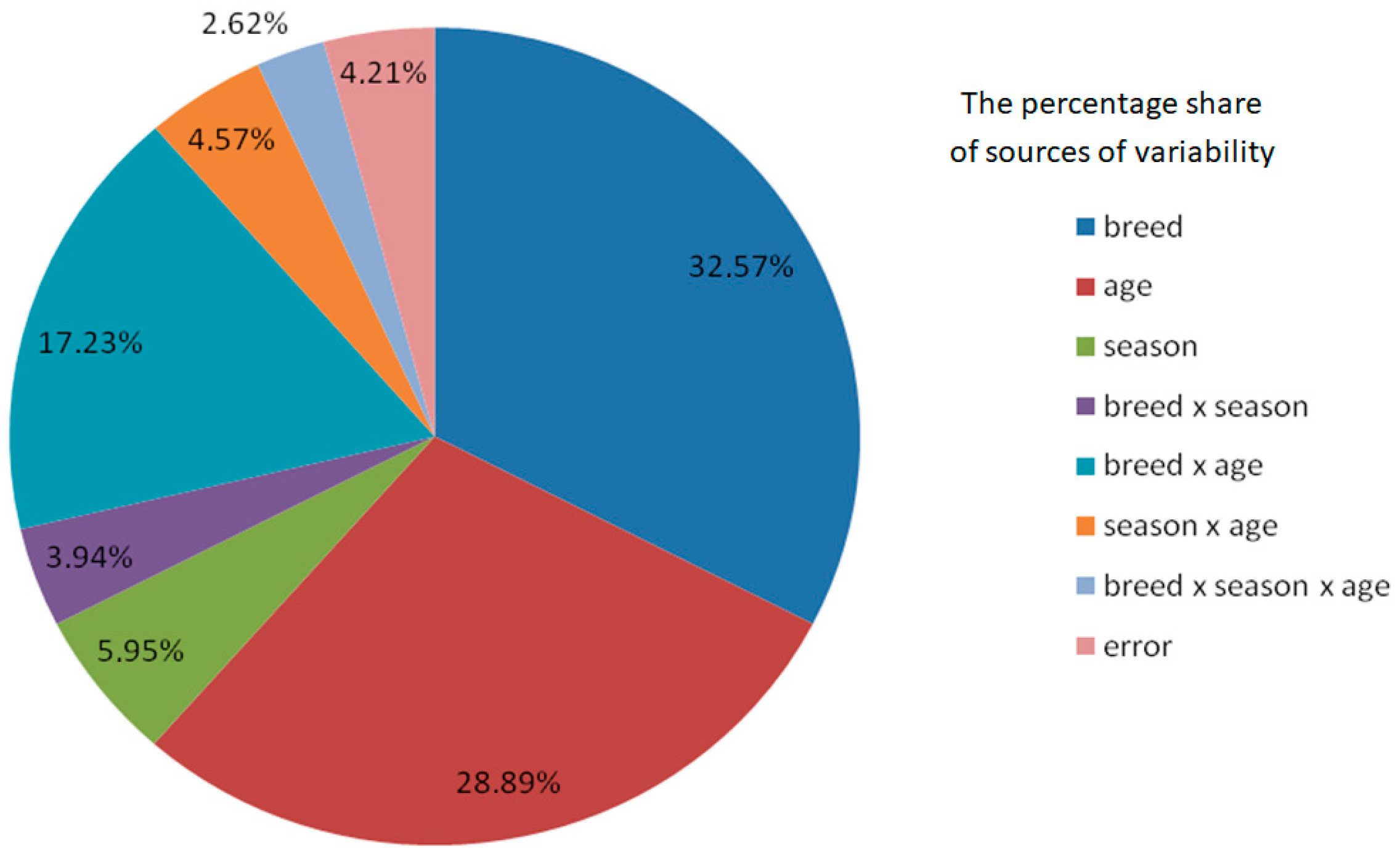
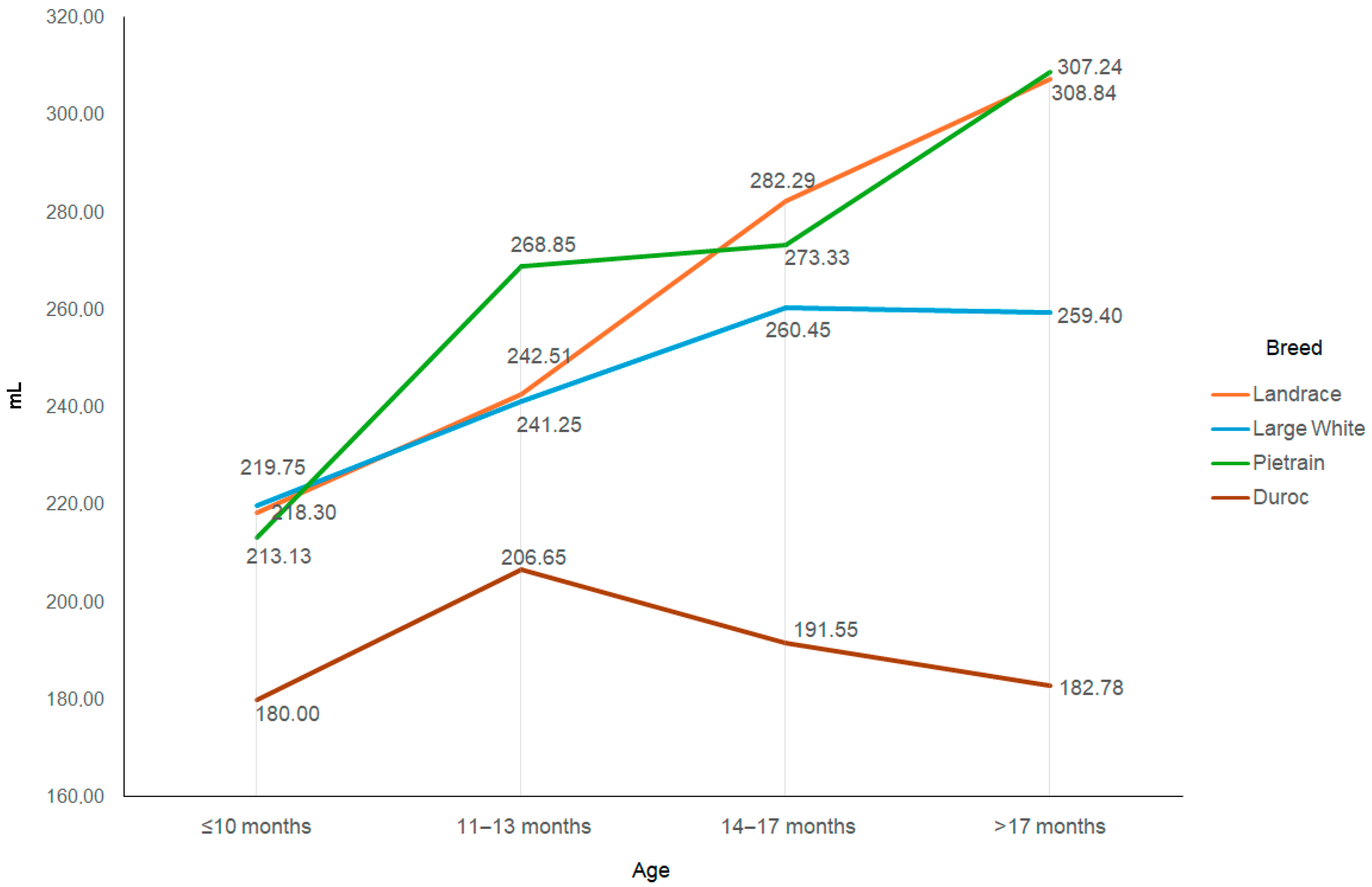
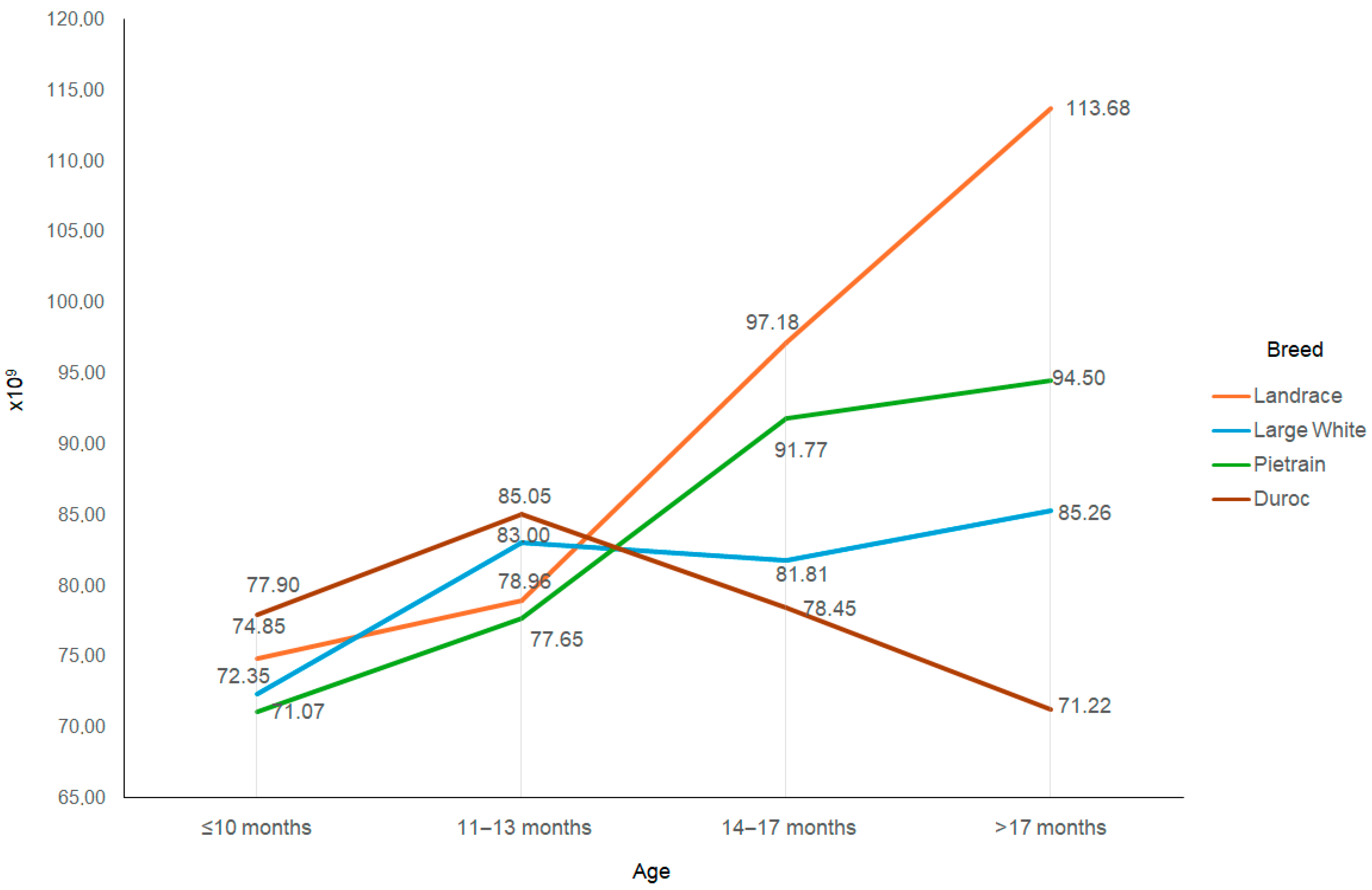
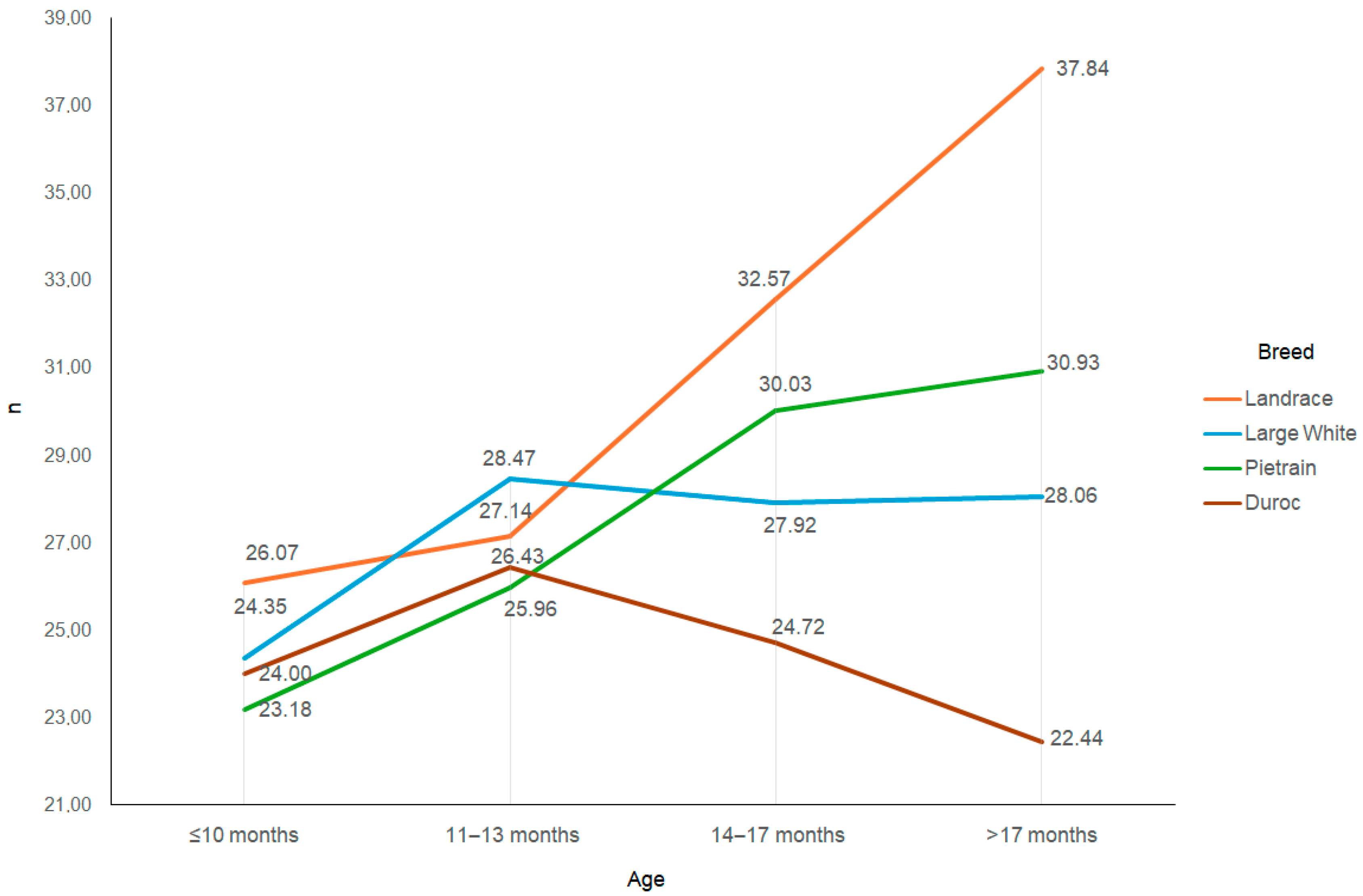
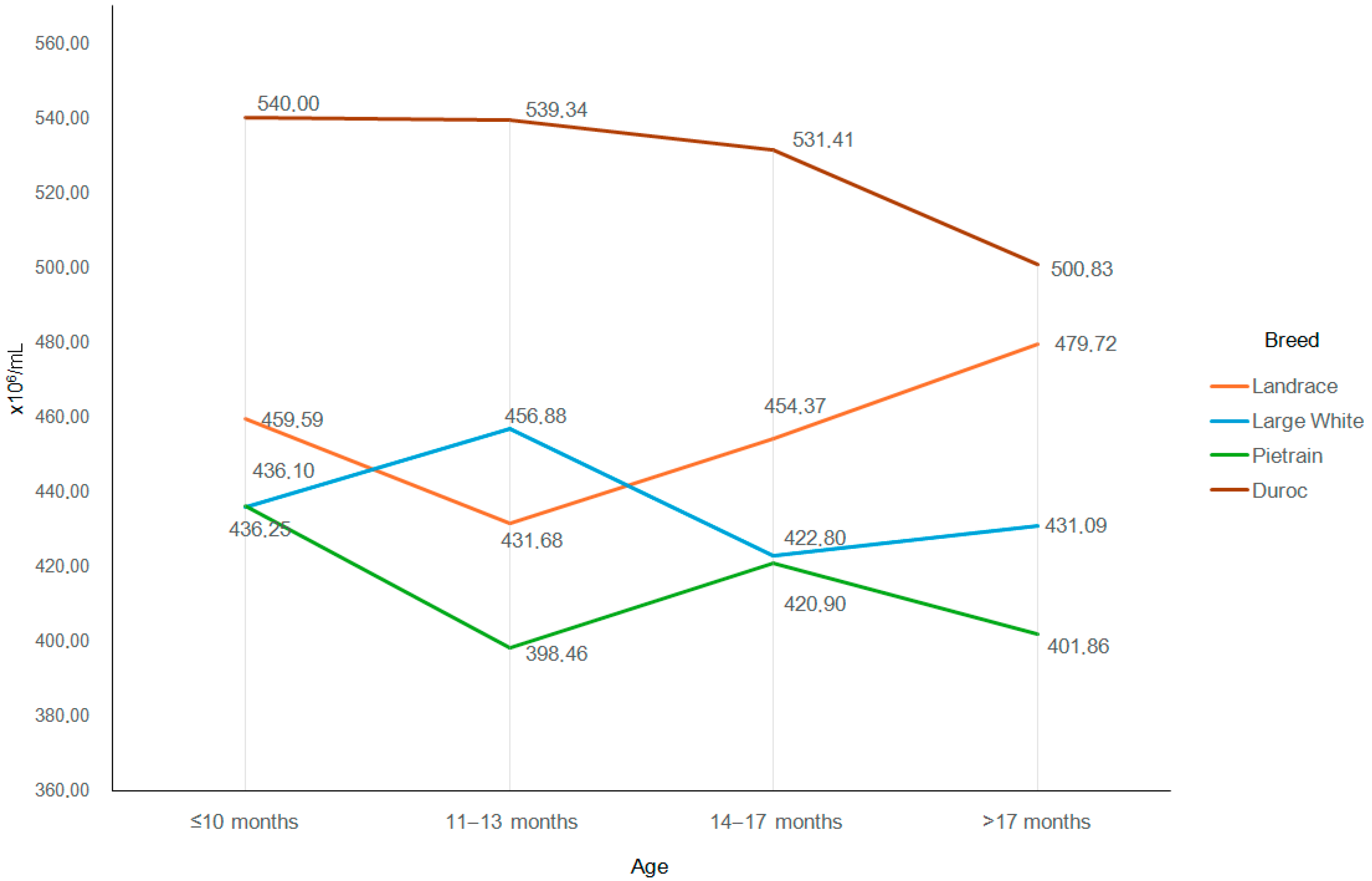

| Specification | Sum of Mean Square Deviations | Mean Square Deviations for Individual Sources of Variation | ||||||||
|---|---|---|---|---|---|---|---|---|---|---|
| Breed | Age | Season | Breed × Season | Breed × Age | Season × Age | Breed × Season × Age | Error | |||
| Ejaculate volume | MS | 148,082.84 | 36,244.06 | 52,909.97 | 18,000.71 | 7068.70 | 10,178.45 | 7130.26 | 9178.05 | 7372.65 |
| % | 100.00 | 24.48 | 35.73 | 12.16 | 4.77 | 6.87 | 4.82 | 6.20 | 4.98 | |
| Sperm concentration | MS | 150,132.58 | 61,289.47 | 5996.45 | 7459.13 | 6607.64 | 22,044.52 | 15,366.32 | 21,134.37 | 10,234.69 |
| % | 100.00 | 40.82 | 3.99 | 4.97 | 4.40 | 14.68 | 10.24 | 14.08 | 6.82 | |
| Sperm motility | MS | 143.43 | 18.84 | 12.94 | 13.08 | 18.42 | 18.95 | 24.01 | 19.18 | 18.01 |
| % | 100.00 | 13.13 | 9.02 | 9.12 | 12.84 | 13.21 | 16.74 | 13.37 | 12.56 | |
| Total number of spermatozoa | MS | 19,727.73 | 6425.21 | 5699.87 | 1174.08 | 778.17 | 3400.06 | 902.39 | 516.87 | 831.08 |
| % | 100.00 | 32.57 | 28.89 | 5.95 | 3.94 | 17.23 | 4.57 | 2.62 | 4.21 | |
| Number of insemination doses per ejaculate | MS | 2346.66 | 842.89 | 633.32 | 146.79 | 109.75 | 377.13 | 87.56 | 59.79 | 89.42 |
| % | 100.00 | 35.92 | 26.99 | 6.26 | 4.68 | 16.07 | 3.73 | 2.55 | 3.81 | |
| Specification | Breed | ||||
|---|---|---|---|---|---|
| Landrace | Large White | Pietrain | Duroc | ||
| Number of ejaculates (n) | 381 | 354 | 118 | 90 | |
| Ejaculate volume (mL) | mean | 265.33 a | 249.04 a | 277.11 a | 191.08 b |
| SD | 91.07 | 96.92 | 93.02 | 51.68 | |
| Sperm concentration (×106/mL) | mean | 456.54 a | 435.37 b | 411.10 b | 529.23 c |
| SD | 99.65 | 108.21 | 87.03 | 117.53 | |
| Sperm motility (%) | mean | 77.58 ab | 77.59 ab | 76.77 a | 78.77 b |
| SD | 4.28 | 4.34 | 4.69 | 3.29 | |
| Total number of spermatozoa (×109) | mean | 92.22 a | 81.55 b | 86.85 ab | 78.57 b |
| SD | 34.24 | 29.81 | 25.89 | 20.62 | |
| Number of insemination doses per ejaculate (n) | mean | 31.22 a | 27.51 b | 28.53 ab | 24.54 c |
| SD | 11.26 | 9.47 | 8.84 | 6.68 | |
| Specification | Age | ||||
|---|---|---|---|---|---|
| ≤10 months | 11–13 months | 14–17 months | >17 months | ||
| Number of ejaculates (n) | 175 | 225 | 284 | 259 | |
| Ejaculate volume (mL) | mean | 213.92 a | 241.41 b | 263.29 c | 280.38 c |
| SD | 73.67 | 80.07 | 92.69 | 105.30 | |
| Sperm concentration (×106/mL) | mean | 459.00 a | 448.25 a | 445.79 a | 449.48 a |
| SD | 98.89 | 107.68 | 106.67 | 113.42 | |
| Sperm motility (%) | mean | 77.82 a | 77.64 a | 77.57 a | 77.45 a |
| SD | 4.27 | 4.25 | 4.29 | 4.36 | |
| Total number of spermatozoa (×109) | mean | 74.04 a | 80.94 a | 88.52 b | 96.57 c |
| SD | 20.99 | 26.18 | 29.94 | 37.19 | |
| Number of insemination doses per ejaculate (n) | mean | 25.01 a | 27.43 ab | 29.63 b | 31.84 c |
| SD | 7.40 | 8.33 | 9.98 | 12.24 | |
| Specification | Season | ||||
|---|---|---|---|---|---|
| Spring | Summer | Autumn | Winter | ||
| Number of ejaculates (n) | 224 | 257 | 238 | 224 | |
| Ejaculate volume (mL) | mean | 244.64 a | 244.84 a | 270.35 b | 254.83 ab |
| SD | 83.08 | 89.22 | 100.62 | 97.34 | |
| Sperm concentration (×106/mL) | mean | 462.41 a | 448.61 a | 439.63 a | 449.54 a |
| SD | 109.97 | 103.58 | 101.88 | 113.91 | |
| Sperm motility (%) | mean | 77.41 a | 78.09 a | 77.56 a | 77.27 a |
| SD | 4.39 | 3.93 | 4.39 | 4.46 | |
| Total number of spermatozoa (×109) | mean | 84.96 a | 84.35 a | 90.25 a | 85.42 a |
| SD | 30.92 | 32.30 | 31.73 | 28.26 | |
| Number of insemination doses per ejaculate (n) | mean | 29.12 a | 27.97 a | 29.97 a | 28.41 a |
| SD | 10.19 | 10.61 | 10.55 | 9.11 | |
Disclaimer/Publisher’s Note: The statements, opinions and data contained in all publications are solely those of the individual author(s) and contributor(s) and not of MDPI and/or the editor(s). MDPI and/or the editor(s) disclaim responsibility for any injury to people or property resulting from any ideas, methods, instructions or products referred to in the content. |
© 2025 by the authors. Licensee MDPI, Basel, Switzerland. This article is an open access article distributed under the terms and conditions of the Creative Commons Attribution (CC BY) license (https://creativecommons.org/licenses/by/4.0/).
Share and Cite
Kondracki, S.; Górski, K. Analysis of Factors of Variation in Characteristics of Boar Ejaculates. Animals 2025, 15, 2043. https://doi.org/10.3390/ani15142043
Kondracki S, Górski K. Analysis of Factors of Variation in Characteristics of Boar Ejaculates. Animals. 2025; 15(14):2043. https://doi.org/10.3390/ani15142043
Chicago/Turabian StyleKondracki, Stanisław, and Krzysztof Górski. 2025. "Analysis of Factors of Variation in Characteristics of Boar Ejaculates" Animals 15, no. 14: 2043. https://doi.org/10.3390/ani15142043
APA StyleKondracki, S., & Górski, K. (2025). Analysis of Factors of Variation in Characteristics of Boar Ejaculates. Animals, 15(14), 2043. https://doi.org/10.3390/ani15142043





